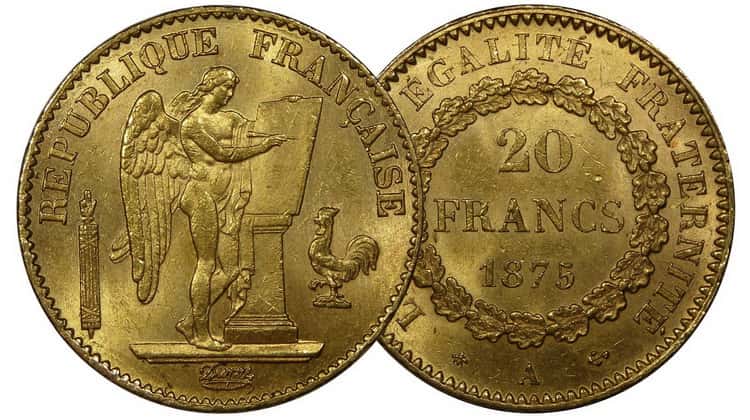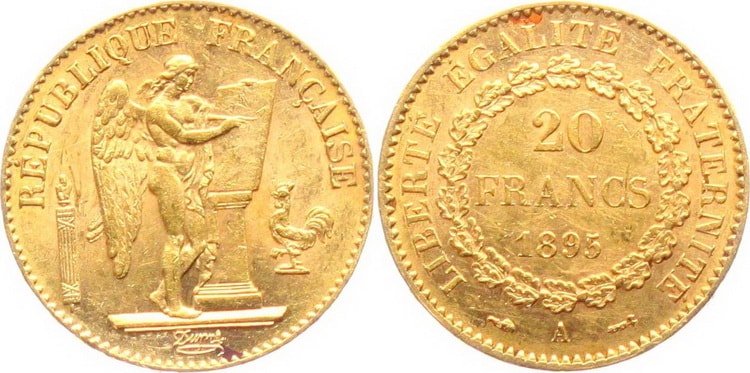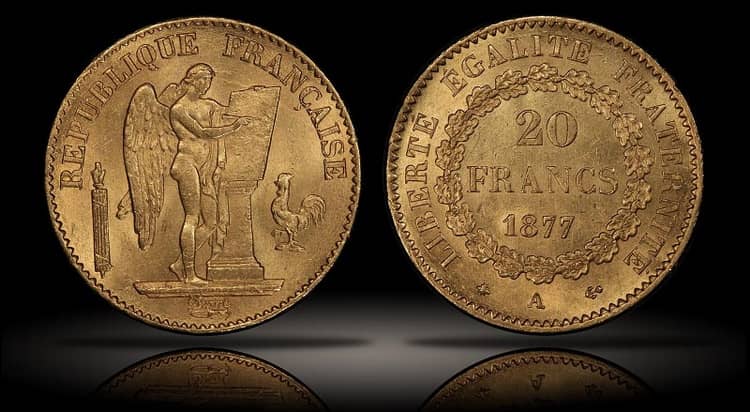
20 francs of the “Angel” series (1871-1898) are the gold coins, which were issued in France during the French Third Republic. Despite the fact that the numismatists of the whole world prefer to call them the Napoleon coins, regardless of whether the acting governor was depicted on the obverse, the French called them “Angels” or “Geniuses”. The name of these coins is caused by the name of the genius, the guardian spirit in Roman mythology, which leads the definition of the talents and capabilities of a particular. Nowadays, angels-genius of 20 francs denomination are the subject of desire for collectors and investors from different countries.
Characteristics of the coin
Years of Issue: 1871-1898.
Material: Gold .900.
Diameter: 21 mm.
Weight: 6.45 g
The edge: the inscription “LIBERTÉ ÉGALITÉ FRATERNITÉ” (Liberty, Equality and Fraternity).
Circulation: 1871/508000, 1874/216000, 1875/746000, 1876/825000, 1877/759000, 1878/189000, 1879/38000, 1886/985000, 1887/231000, 1888/28000, 1889/873000, 1890/30000, 1891/871000, 1892/225706, 1893/2517000, 1894/91000, 1895/293000, 1896/330000, 1897/11069000, 1898/8886000.
Obverse: on the obverse side of the coin there is the image of an angel standing with a pen before the sheet of parchment on a stand. Above him, there is the inscription “RÉPUBLIQUE FRANÇAISE”. To the right of the angel, behind the stand is depicted a rooster, a symbol of France. Below there is an autograph for a coin designer.
Reverse: on the reverse side of the coin, there is an indication of denomination and year of issue of the sample, both of them are framed with a laurel wreath. Above the wreath there is the inscription “LIBERTÉ ÉGALITÉ FRATERNITÉ”.

Coin History
The basis for the gold coins of 20 francs of the period of French Third Republic, was the Napoleon coins, which were minted for Napoleon Bonaparte in two denominations of 20 and 40 francs. The coin of 40 francs did not become popular, and its production was soon stopped. Later, the coins of 5, 10, 50 and 100 francs denomination were issued, but numismatists consider 20 francs denomination as real Napoleon coin.
Originally, the coins were decorated with a portrait of Napoleon I, sometimes with an uncovered head, but more often with a laurel wreath, which is an ancient Roman symbol of imperial or military glory. The words engraved on the obverse varied depending on the political situation in France: at the very beginning, the obverse of the coin was decorated with the inscription “First Consul”, and later − “Emperor Napoleon”. On the reverse side of the coin was engraved “RÉPUBLIQUE FRANÇAISE” (French Republic), and after 1809 the inscription changed to “EMPIRE FRANÇAIS” (French Empire).
In 1814, when Louis XVIII was reestablished on the throne of France (restoration), France changed its flag. However, French coins have not significantly changed – the picture of Napoleon was replaced with the portrait of the king. In that period there were the rumors that Louis XVIII intended to destroy the reforms of the revolution, to return to the twelfth system and the livres of the former regulation. It did not happen, so the new coins were issued with the same weight and purity that were provided by Napoleon Bonaparte.
At the end of 1865, the Latin Monetary Union was created, and France was one of its founding countries. The LMU adopted the specification of the French gold franc, which was introduced by Napoleon I in 1803 and was presented in denominations of 5, 10, 20, 40, 50 and 100 francs. 20 francs denomination weighing 6.45161 grams of gold with purity of .900 was the most common coin. In the French payment system, the gold franc was interchangeable with the silver franc on the basis of the exchange ratio of 1: 15.5. This ratio was based on the actual cost of these two metals in 1803.

When Belgium, Switzerland and Italy joined the created alliance, all these countries settled the combined gold and silver bimetallic standard and established the ratio of gold to silver adopted in France. One gold franc became an international currency, its net weight was 0.290322 grams of gold.
The convention required all four states to exchange gold and silver coins freely in accordance with the general specifications. Until the conclusion of the agreement, for example, the purity of silver coins in all countries of the Union varied from .800 to .900.
According to the new convention, the silver coin of France with the highest denomination of 5 francs, should be .900 purity, while smaller copies of 2 francs, 1 franc, 50 centimes and 20 centimes − .835. The LMU functioned to facilitate trade between different countries by setting standards for gold and silver to be minted and exchanged. Thus, a French trader could accept an Italian lira for his goods, with confidence that it could be converted back to a comparable sum of francs.
Cost of coins

French coins are always in the price, whether it is ancient or modern golden and silver coins produced in the country’s Mint. Gold coins of 20 francs denomination of the period described can be easily found in free sale – which is caused by large circulations. Nowadays, the price of one sample is approximately USD $ 280. However, in some auctions or trading platforms, the cost of an “Angel” can reach $ 500 USD.
Interesting facts
● Napoleon coin, like many other ancient French coins, was minted not only by the Paris Mint. It is known that the Italian Mint in Turin for one time minted coins of 20 and 40 lire, dedicated to Napoleon I. The obverse of these coins tells about the release of Bonaparte of Italy from the Austrian occupation, engraved with the inscription “L’Italie Délivrée à Marengo” (Battle for Italy with Marengo). On the reverse side there are references to the liberated lands. Coins were put into production by the special decree of the Government of Gaul of Subalpine, created after the battle at Marengo near Alessandria in Turin. The government as well as the coins, lasted only a year.
- Coins of 20 francs denomination with the image of an angel were minted not only during the specified period, but also earlier − from 1848 to 1849. Despite the same purity used in the production of gold, weight and diameter, these coins have slight differences in design: in the earlier samples on the parchment before the angel, there arewritten symbols − the first words of the French Constitution. There are also differences concerning the inscription on the group: coins issued in 1848-1849 contain the inscription “DIEU PROTÈGE LA FRANCE” (God save France). Changing this inscription is caused by the state department and the church in France.
- The “Angels” production was stopped in 1898, however, the coins of “Rooster” series of 10 and 20 francs denomination replaced them. This series was issued up to the start of the First World War. On the reverse side of the coin, the rooster is engraved, and on the obverse is depicted the profile of Marianne − the revolutionary symbol of France. These coins were as good as the previous ones, but nowadays they are considered to be more rare because about one million golden “roosters” of 20 francs have been remelted in the USA during a campaign of gold confiscation from the population. Even more such coins were remelted in the 70s of the last century, when the price of gold significantly jumped.
#BBD0E0
»
Comments
No commens yet.